A Look at the Rawland rSogn
A week ago, I spotted a Rawland rSogn at the Brevet Season Kick-Off Party I wrote about earlier. Never having seen one in person before, I was extremely excited by the sighting.
Turns out this rare specimen belongs to local cyclist Jon D. Generous and trusting, Jon offered to lend me the bike to photograph and test ride. Long story short, Jon's Rawland is now staying over for a visit.
The story of how the rSogn came into existence has become almost legendary in bikey/internet circles, as apparently Sean asked for feedback in an open forum and tweaked the specs based on popular suggestions.
The result was a frameset with cantilever brakes, no toe overlap, massive tire clearance, eyelets for racks and fenders, and a variety of braze-ons including a pump peg on the left chain stay. Full specs are available here.
Aesthetically, my favourite part of the bike is the massive, double-plated fork crown - difficult to photograph because of the front rack attachment, but in person a commanding presence for sure.
The front rack is designed especially for the Rawland rSogn by Haulin' Colin. It is 12" wide and can support a great deal of weight.
Jon uses the rack to carry heavy loads when cycling for transportation, but for road rides and brevets he attaches a small Acorn handlebar bag.
The bag is attached to the rack alone and does not require a decalleur; it appears to be pretty stable. To carry it off the bike, Jon uses a long Surly toe strap as a shoulder strap. Walking away with the bag slung over his shoulder, he left me alone with the Rawland.
While I love having the Rawland around to photograph, unfortunately I cannot review it - it is just too large for me. The frame measures 53cm x 57cm with a sloping top tube. Not only is the reach quite long, but even if we were to flip the stem and move the spacers, the handlebars would still be several inches higher than what's on my other bikes right now. Additionally, I am not comfortable using downtube shifters on serious rides, and there is no easy way to change this aspect of the build. All in all it just wouldn't be fair to attempt a review out of this. But what I can do is provide some feedback that is not test-ride-dependent.
On the positive side, I find the frame to be well-made and well thought-out. The joints are clean and do not call attention to themselves, the braze-ons precise, the fork crown beautifully executed. I really like the paint colour and the general frame aesthetics. I like that there is no toe overlap (though it's close and could depend on your shoe size and pedals). And the low trail design with clearance for 650B x42mm Grand Bois Hetres is what drew me to the frame in the first place.
As for drawbacks, the main one for me is weight: As shown, the Rawland rSogn weighs about as much as my similarly built Rivendell Sam Hillborne - close to 30lb. I am told by those who've ridden both bikes that the Rawland is more responsive and faster, particularly uphill, and that is good to know. But I'll be honest: I am a little tired of heavy roadbikes. I would like something lighter, and I know it's possible. Aside from this, I would of course prefer it if the frame were lugged, but that is a matter of personal taste. The double-plated fork crown and the decorative lugwork on the headtube do create sufficient visual interest to keep me from dwelling on this for too long.
Similarly to my Rivendell, the long and sloping top tube makes the fit of the rSogn somewhat tricky: Assuming that the rider wants their handlebars at or below saddle-height, they must pay attention to the top tube and head tube measurements, and not to the seat tube measurement in which the sizes are given. And judging by those measurements, the rSogn is not currently available in a size small enough to fit me well.
Coincidentally, Rawland has a new model coming out - the Nordavinden - that could address both of the above issues. It is a lighter, sportier frame, with an almost level top tube, and they are offering it in a size equivalent to the size I normally ride. While the larger frames are designed for 700C wheels, the smallest (my size) will be 650B with clearances for 42mm tires. If I were to consider a Rawland for myself, I think this model might be more appropriate for me than the rSogn. [Edited to add: There is now a review of the Nordavinden.]
For those interested in trying a low trail 650B randonneuring bicycle without the wait and expense of a custom built frame, the Rawland rSogn is a great deal. There are many happy owners who ride long brevets on these bikes. The Chasing Mailboxes couple each have one. Chris Kostman of AdventureCORPS has one and it is his favourite bike. And here is another owner's in-depth review.
Turns out this rare specimen belongs to local cyclist Jon D. Generous and trusting, Jon offered to lend me the bike to photograph and test ride. Long story short, Jon's Rawland is now staying over for a visit.
So what is so special about this bike? The Rawland rSogn is a production randonneuring frameset, made for 650B wheels and wide tires, with low trail geometry and standard sized tubing. Currently priced at $725 and available without a wait list, it is the most accessible frameset with this combination of characteristics available on the market today, as far as I am aware.
Not everything about the rSogn is "classic randonneur." The dramatically sloping top tube, mostly welded frame, and threadless steerer mark it as a modern bike. But for anyone interested in trying out the low trail/ 650B handling characteristics, this is a comparatively affordable way to go. And it's not just about affordability: rSogn owners seem very pleased with this model - describing it as fast, responsive, and comfortable over long distances. It is reputed to be a fast brevet/ road-to-trail bike that fits cushy tires and is optimised to carry a front load.
Rawland Cycles is a tiny operation based in Danville, California. Owner Sean and his spouse Anna run the company and design the frames, which are hand-made in Taiwan. Sean is of Norwegian heritage and he pays tribute to this with the Nordic theme that runs through everything from the company name, to bicycle model names, to the graphics and even frame design.The story of how the rSogn came into existence has become almost legendary in bikey/internet circles, as apparently Sean asked for feedback in an open forum and tweaked the specs based on popular suggestions.
The result was a frameset with cantilever brakes, no toe overlap, massive tire clearance, eyelets for racks and fenders, and a variety of braze-ons including a pump peg on the left chain stay. Full specs are available here.
Here is a side view. The flat top of the crown is engraved with Rawland's Nordically-stylised "R."
The decorative motif on the seat tube complements the font used elsewhere on the decals.
The bicycle's owner built up the frame with a needle-bearing headset, dynamo lighting, downtube shifters, cantilever brakes, a wide range double drivetrain, handlebars set slightly above saddle level, and a large custom front rack. The build is heavy on Velo Orange, mixed with Shimano, IRD, Grand Bois, Berthoud, Cane Creek, and other usual suspects. If you have a question about specific components, please ask in the comments.
Jon rides clipless, but he switched the pedals out for flat ones so that I could ride the bike. For tires, he switches between the 42mm cream Grand Bois Hetres for road-to-trail riding and 2" knobby Pacenti Quasi-Moto tires for rougher off-road stuff.
While I love having the Rawland around to photograph, unfortunately I cannot review it - it is just too large for me. The frame measures 53cm x 57cm with a sloping top tube. Not only is the reach quite long, but even if we were to flip the stem and move the spacers, the handlebars would still be several inches higher than what's on my other bikes right now. Additionally, I am not comfortable using downtube shifters on serious rides, and there is no easy way to change this aspect of the build. All in all it just wouldn't be fair to attempt a review out of this. But what I can do is provide some feedback that is not test-ride-dependent.
On the positive side, I find the frame to be well-made and well thought-out. The joints are clean and do not call attention to themselves, the braze-ons precise, the fork crown beautifully executed. I really like the paint colour and the general frame aesthetics. I like that there is no toe overlap (though it's close and could depend on your shoe size and pedals). And the low trail design with clearance for 650B x42mm Grand Bois Hetres is what drew me to the frame in the first place.
As for drawbacks, the main one for me is weight: As shown, the Rawland rSogn weighs about as much as my similarly built Rivendell Sam Hillborne - close to 30lb. I am told by those who've ridden both bikes that the Rawland is more responsive and faster, particularly uphill, and that is good to know. But I'll be honest: I am a little tired of heavy roadbikes. I would like something lighter, and I know it's possible. Aside from this, I would of course prefer it if the frame were lugged, but that is a matter of personal taste. The double-plated fork crown and the decorative lugwork on the headtube do create sufficient visual interest to keep me from dwelling on this for too long.
Similarly to my Rivendell, the long and sloping top tube makes the fit of the rSogn somewhat tricky: Assuming that the rider wants their handlebars at or below saddle-height, they must pay attention to the top tube and head tube measurements, and not to the seat tube measurement in which the sizes are given. And judging by those measurements, the rSogn is not currently available in a size small enough to fit me well.
Coincidentally, Rawland has a new model coming out - the Nordavinden - that could address both of the above issues. It is a lighter, sportier frame, with an almost level top tube, and they are offering it in a size equivalent to the size I normally ride. While the larger frames are designed for 700C wheels, the smallest (my size) will be 650B with clearances for 42mm tires. If I were to consider a Rawland for myself, I think this model might be more appropriate for me than the rSogn. [Edited to add: There is now a review of the Nordavinden.]
For those interested in trying a low trail 650B randonneuring bicycle without the wait and expense of a custom built frame, the Rawland rSogn is a great deal. There are many happy owners who ride long brevets on these bikes. The Chasing Mailboxes couple each have one. Chris Kostman of AdventureCORPS has one and it is his favourite bike. And here is another owner's in-depth review.
And of course there is Jon, this particular bicycle's owner. Jon is only a little taller than I am and does not have the bike set up in a particularly aggressive manner. But according to his riding buddies, he is super fast on it. Jon has other bicycles, but the Rawland rSogn is his favourite - both for commuting and for brevets. Last year he completed a good chunk of the Boston Brevet Series on this bike, and hopes to do more, longer ones this year. He also rides quite a bit off road, and his rSogn turns into a mountain bike when fitted with fat knobby tires.
As usually happens with bicycles I am excited about, there is too much information to fit into a post without making it ridiculously long. If you have any specific questions, please ask and I am sure a number of owners reading this will be glad to give you feedback. My sincere thanks to Jon for being so nice and loaning me his bike. It is doing well here and making new friends. Full set of pictures here!

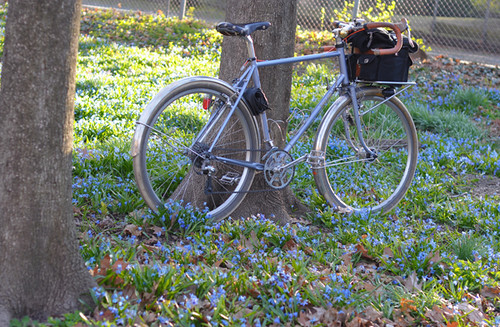
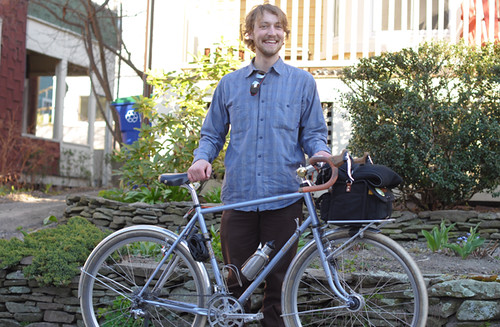
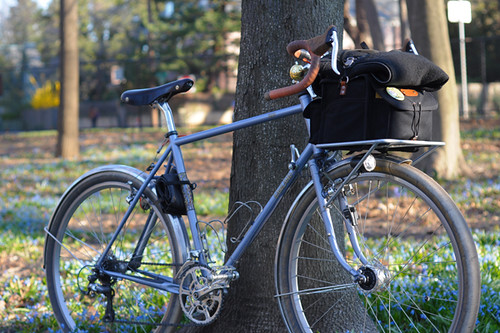
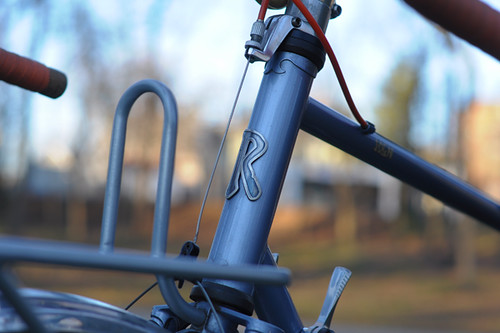
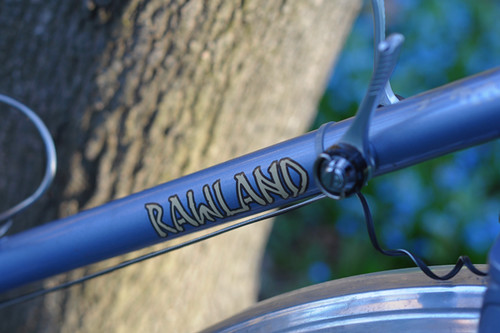
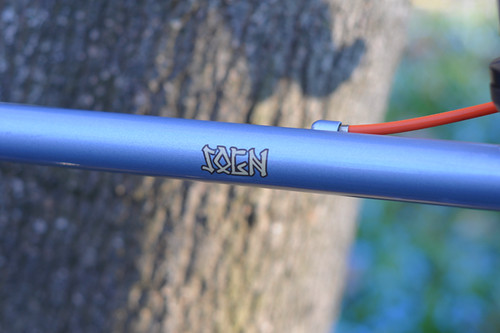
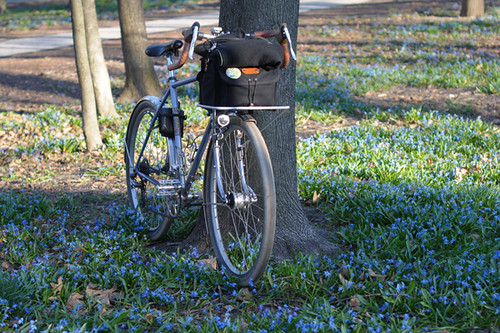
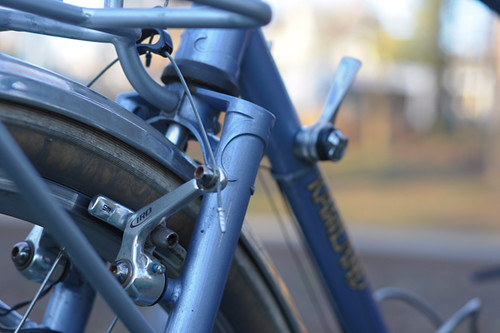
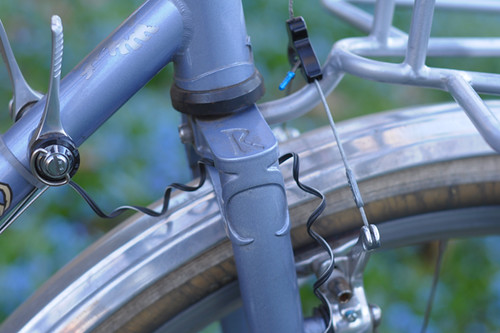
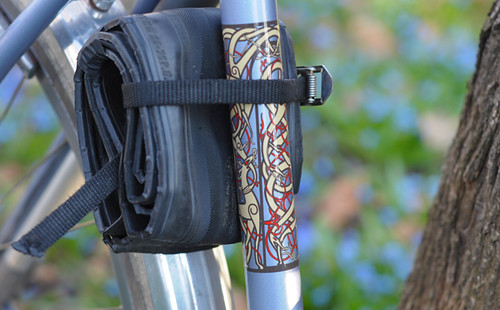
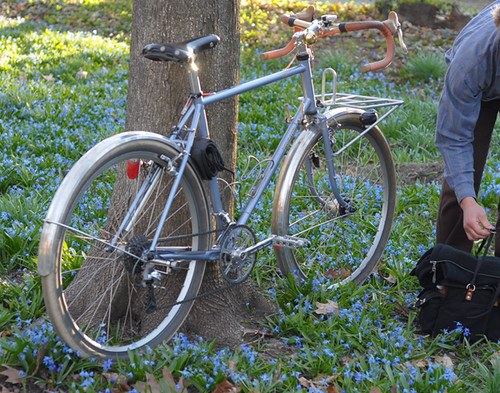
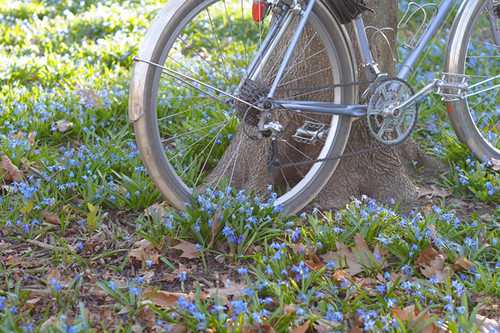

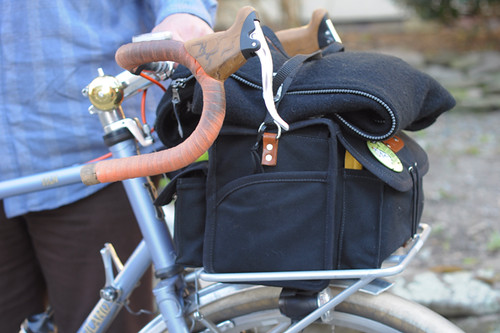
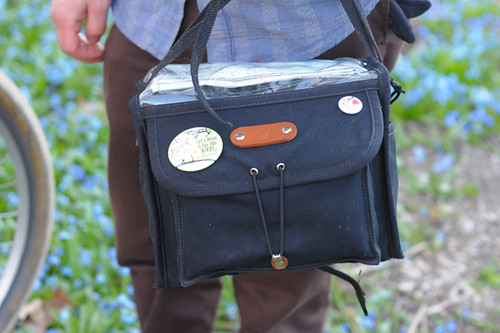
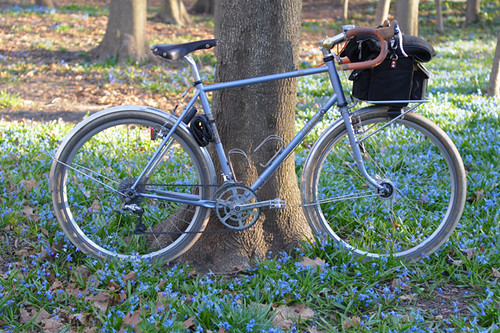
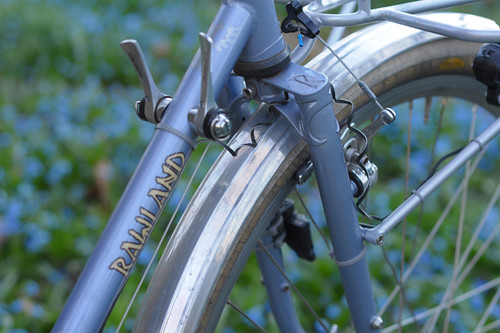
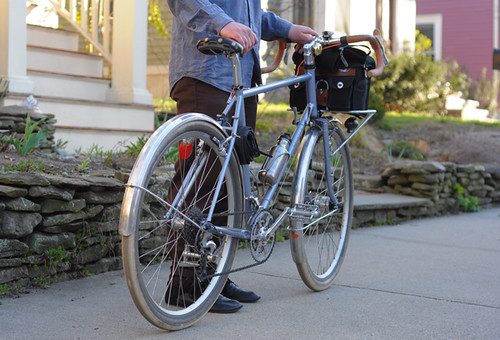
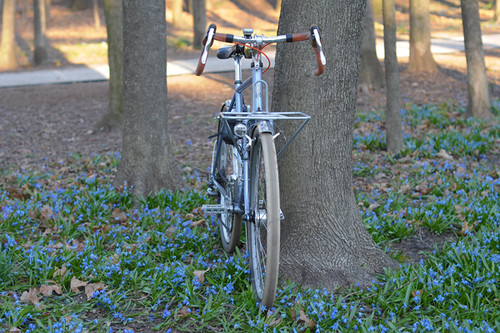
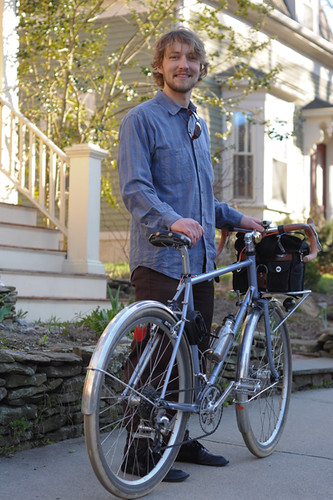
Rawland says it will have a Ti version called the RSogn available sometime this Spring. The frame will be made in the U.S.. It uses the same steel fork as the bike you review.
ReplyDeleteRawland does not show the final price yet. Imagine somewhere around 2k.
Not easy to get a light weight steel bike in at the price. The least expensive I know of is the Boulder, with frame and fork roughly twice the Rawland. VO parts are not going to be featured on weight weenies any time soon. To save weight you will have to spend more and settle for less attractive.
I think the ti version was promised for sometime LAST spring, but that conversation seems to have gone silent.
DeleteMy understanding is that it's not happening.
Delete"But I'll be honest: I am a little tired of heavy roadbikes. I would like something lighter...." Ah! Those heavy bikes with those big, fat, heavy tires. IMO, if you ride 35mm+ tires on the road you're cheating yourself.
ReplyDeleteAll of my riding is on paved roads and I use 22mm-25mm tubulars. It really makes a huge difference. BTW, if tubulars are mounted properly they are safer than clinchers. When are you going to give us your take on tubular tires?
I've already ridden on 23mm tubulars, including off road! See here - this was 2 summers ago.
DeleteIn your opinion, Don.
DeleteThe Schwalbe Kojak at 35 mm is a wonderful, plush road tire. That is a joy to ride. Challenger and Grand Bois make great 28 to 32 700 tires. The large 650b tires by Grand Bois are equally wonderful.
I have a clincher and tubular wheel set for my 700 bike. Between the Grnad Bois Serfs on my 700 and the Hetrees on my 650b, I have only ever bothered to mount the tubular wheel set once. The ride was not any better, so why bother? They sure look cool though.
"The ride was not any better, so why bother?" Reread "...if tubulars are mounted properly they are safer than clinchers."
DeleteWith 35c road tires, I can ride any of our epic Sonoma County road rides, and then hit up the secret singletrack tucked into the hills. Then I can ride home.
DeleteI can't do that on 23's.
Shut your pie hole and stick to the asphalt.
We'll be having fun in the dirt.
To compliment my Sam Hillborne I have decided to purchase a Rivendell Roadeo and one of the factors weighing my decision was the fact that the bike easily handles 32s. I will be riding this primarily as a club ride bike and don't feel I will be suffer any handicap.
DeleteSee, the thing is, with wider tires that aren't pumped up rock hard, you can ride over the bumps, rocks, washboard stuff without suffering speed degredation and your body will be less fatigued in the end. It's a win/win situation.
The downside is weight of the wheel and tire combo of course, but it turns out that doesn't really make much difference unless you are riding the Tour de France. I am not, are you?
V: Thanks for this post about my favorite bike, and thanks for linking over to my post about mine. Now you have me curious as to its weight. I'll have to see if the local shop has a hanging scale so that I can weight it. But it's never struck me as heavy; certainly nowhere near 30 pounds. I'm guessing your test bike is set up with some heavy components, plus it does have fenders, a big rack, and such. All that adds up. Living in Sunny SoCal, I don't have fenders and I only place a small Grand Bois M-13 rack on the front when I need it. So mine is quite svelte and it rolls like a road bike.
ReplyDeleteAs for the proposed titanium version, I'm not sure that's even in development anymore. Also, when compared to light-weight steel, a ti frame is usually only about one pound lighter, so I wouldn't look to ti as a way to make this bike model lighter. Ti is usually offered for its particular ride qualities, corrosion resistance, and unpainted finish. (A perfect example of that is the Ritchey Break-Away, which is offered in both steel and ti and there is only a one-pound difference.)
ReplyDeleteAs of this post, the Rawland site still has the deposit link for The Ti frame and fork.
DeleteMJ: No, there's not any ti Sogn deposit available anymore on the Rawland site.
DeleteRawland's delivery dates need to be treated as optimistic approximations, subject to substantial change with little notice and no explanation. :-)
DeleteThis bike looks well equipped for it's intended use and must have a great ride quality based on the rave reviews of others and the smile on Jon's face. It looks like a bike he uses and loves. Personally, the look is appealing because of it's simplicity. Not the visual overload of the custom lugged model you referenced. And the fact that it's affordable and available makes it a winner! Thanks for sharing this beauty.
ReplyDeleteI agree that there is something clean and simple about this frame design that, together with the light colour, is appealingly minimalist. The custom bike I referenced has an entirely different aesthetic and I mentioned it for the weight comparison.
DeleteGood morning! This post is a welcome surprise. I have been considering the rSogn all winter, just trying to decide on frame size. Thanks for the review, the beautiful pictures, and the warning about fit. I see now that I probably need to go with a smaller frame than I thought!
ReplyDeleteSincerely,
Paul
Re your sizing, holler at Sean and Anna at info@rawlandcycles.com. They will dial you in perfectly!
DeleteThe weight is probably mostly from the build. My dSogn comes in at around 30lbs but it's got a generator hub, porteur rack, disc brakes and stainless steel fenders. With a bit of selection in components it probably could be brought down to the mid twenties easily. With some choosing for weight you might hit the low 20's. I built mine as a car replacement though. At 30 it's still much faster than my 24lb salsa. I'm also 6'2" and upwards of 250 so anything that fits me is fairly stout.
ReplyDeleteRegarding my comment on weight:
ReplyDeleteI am kind of surprised and feel a little bad that out of everything I wrote about the bike it's this comment that stood out.
First I want to say that the comment was more about my personal preferences than a judgment of the bike. Plenty of people are quite comfortable with 30lb builds that include dynamo lighting and all the other accoutrements seen here. My husband's Surly Cross-Check is around 30lb the way he has it set up, and he doesn't find that problematic at all. But me, I am small and weak, and owning my Rivendell for over 2 years now has taught me that, should I ever replace it, one thing I want to be different is the weight. For me, 30lb is too much for a roadbike.
While I know that I could get the weight down by replacing the components with a lightweight racing group, stripping off the fenders and dynamo lighting, and fitting the bike with narrow tires, that would defeat the very purpose of this frame IMO! The 650Bx42mm Grand Bois Hetres, fenders, front rack and dynamo lighting are pretty much fixed requirements for me on this kind of bike.
My collaboration with Royal H Cycles last summer has shown me that it is possible to put together a bike with all of those features and get the weight at 26lb - including both front and rear rack, handlebar bag and empty water bottle - and that figure is probably the limit for my personal comfort zone. Jan Heine's Rene Herse with similar features is around 20lb I believe, but he worked very hard to get to that point. As they say, YMMV!
Some day I would love to test ride a Rawland in my size, and see whether I can get the weight down without compromising on any of the features I want. Judging by the feedback from owners, I should like the handling.
Did the custom build use lighter weight tubing? Also, no mention of the price of the custom as a comparison to the price and availability of the Rawland....
DeleteOh the custom options are much pricier, that goes without saying. Around $2300 for a frameset by Royal H Cycles with a several months wait, which in turn is downright economical and speedy compared to Herse and Weigle pricing and lead times.
DeleteAs I said, the Rawland is a great deal.
I think my Surly is more like 35lbs. It's a much larger frame, with heavier tubing and it doesn't even have a dynohub. And the wheels are 700C with Fat Franks, so heavier than this bike all around. The Rawland build also has a front rack and is still lighter.
DeleteI've set up my salsa vaya with some of the same parts and it comes in about 35lbs with a lighter drivetrain. My comment about weight was just to chime in about where it fits in my experience with bikes. Probably light tourer or solidly built rando build but it would be hard to get it to be sub 20lbs in larger sizes. I've got a large and it fits extremely well.
DeleteBut it rides faster than the weight would indicate. For me it slows down significantly with 700c wheels.
I find that when I gain 5 lbs, my bike is significantly slower.
DeleteWhile bike weight isn't the topic of the posting, it's certainly coming up in the conversation. You need to see this amazing bike by English. I never heard of the builder until recently, but he's building <14lbs. steel road bikes that can still accept 28mm tires. That's amazing, I can't even comprehend getting a bike that light! Would be a LOT of fun to ride.
Deletecyclotourist - Interestingly (and you might already know this), the owner of that English bike also has a custom super-lightweight Rene Herse 650B low trail bike similar to Jan Heine's.
DeleteAnon 01:14 - I find it easier to control my own weight than the bike's. Wish I could make my Riv lose 5lb, but he is stubborn and likes his cake.
RE: Weight of "amazing bike by English". Must be those anorectic chainstays.
DeleteNo it's mainly the super thinwall 5/3/5 True Temper S3 tubing, and a lot of clever design and machining.
DeleteNo, I didn't notice that. Clicking through, he has (has had) a few nice pieces of metal over the years! flickr.com I've over looked him on flickr till now!
Deletethat 14 lb steel road bike has an awful lot of carbon fiber.
Deletesteel is real heavy...
Is the Sogn a rando light bicycle or a light touring bicycle: how many kg can it take besides the rider?
ReplyDeleteYou can have about 5kg on the rear and 20kg on the front very comfortably with adequate racks. You do not want to load up the rear with panniers, or really at all unless there's already weight on the front — the light tubing lets the tail wag the dog, and the low trail steering goes crazy then unless loaded down.
DeleteThe stock Haulin Colin rack that we designed weighs around 400g and only just starts to flex with over 25kg. My prototype has a few extra tubes in it but I've not yet been able to overload it.
With Tubus lowrider racks you can take another 20kg, but it would start to get pretty unwieldy over 35kg.
It's both. All-rounder geometry that works great for rando, light camping, and city, which is what I've been using mine for.
DeleteI like this bike over all, except for the sloping top tube. But I think I could live with it, if they made the bike in my size.
ReplyDeleteIt sounds like you are actively looking to replace your Rivendell at this point. I wonder what you'll end up with.
I am indeed looking to replace my Rivendell SH. I've been working on something with Mercian Cycles, but don't want to speak too soon. If it doesn't work out, I will seriously consider the new Rawland model in my size.
DeleteOn another subject besides weight, I truly think this whole 'low trail' mystique is a triumph of true believers seeing and feeling what they want/expect to see and feel. On this side of the pond I cannot find a single builder who gives trail even the most cursory thought. It is merly the product of head tube angle and fork rake. It is what t is, and generally in the mid-50s, because that's what works. I've taken quite a survey of the finest an most experienced builders over here and no a one gives 'low trail' a second thought. Or even a first. Roff Smith
ReplyDeleteI like low trail handling on some bikes. I like mid trail handling on others. There is a distinct difference, in my experience, but at this stage I do not find either to be inherently 'better.' It is true that many builders think of mid trail as a logical default and are skeptical of low trail. That does not mean they are correct. There are different philosophies out there.
DeleteMy take on the low trail thing is that it's a great idea for ppl who want a substantial front load. The low trail properties counteract any swing-weight. Totally makes sense. I do think that a lot of ppl on the interwebs either have or covet low-trail frames (typically with 650b wheels) b/c they like to talk and/or type about how cool low trail frame design is. (For the most part, this does not apply to regulars on here.) I'd imagine that, with the front unloaded, a low-trail bike would kind of suck.
DeleteThe Rawlands are some of those bikes that never appealed to me at all. But, if you're really working with Mercian on something good, V, I'm eagerly awaiting a post about your plans. I know that may invite too much input from your readers, but i mostly want to see how closely the finished Mercian will resemble your original concept, know what I mean?
-rob (who still wants a mercian, but needs to finish other projects first.)
Screech: With your assumption that "a low trail bike would kind of suck... with the front unloaded", you are perpetuating the mythology, old wives' tales, and baseless rules of thumb which continue to bog down the bike industry.
DeleteI have ridden 95% of my Rawland rSogn's miles with no weight on the front end and it rides great, I can ride it no-hands, it doesn't shimmy, and it is not in the slightest bit "weird" or hard to get used to. And yet, when I load up the front end, it also rides exactly the same way. That is the beauty of low trail front end geometry.
Meanwhile, on my all my mid- and high-trail bikes, while I can ride them just as well without any weight up front, they become essentially unrideable when I put any weight on the front end. Even a water bottle on the bars will get that "swing weight" going that you mentioned. Forget about a handlebar bag, unless I want to ride without ever taking my hands off the bars and squeeze the top tube like mad to keep it from shimmying.
You really ought to try a low-trail bike, with and without weight up front, and you'll see what we're talking about. Then you can make informed comments about how certain geometries work, rather than passing along the rules of thumb which keep most bikes companies still making the same junk, year after year, decade after decade.
XO-1.ORG: Amen! Once you ride low trail, the high-trail bikes' handling reeks of bad design and poor functionality unless you're unloaded and always at high speed. It's Italian racing bike geometry, and it's a classic human perpetuated error that it now dominates bike design. Kind of hilarious, actually. We had the answer and lost it, as with so many other things.
DeleteClassic Italian was 74 head with 50mm rake for 45mm trail. What happened was the roads got better. The gruppo became more and more compatto. Speeds got higher. In those conditions 57mm trail makes a lot of sense. Less than 45 trail is very difficult to manage in a high speed group. Those who talk about how easy their low trail bike is in a paceline aren't going that fast and/or benefit from inordinate skill and respect/accomodation from their riding companions. It would be nice if mfrs continued to offer a classic geometry option for those of use who do not go wheel to wheel at 50kph for extended stretches. But there is custom and vintage remains a huge bargain.
DeleteVelouria - Id be interested if you are talking with Mercian what the outcome will be.
ReplyDeleteIm looking at potentially two projects with Mercian:
1) renovating my old Condor
2) Buy Something similar to the bike in this article.
I will be in Derby shortly and may pop in for a quick nose at what theyve got to offer.
I know nothing about 650b wheels. What I want is a bike that will be light in weight, able to do road AND off road (ie well packed tracks). I like wider tyres for the stable, comfort factor.
And Reynolds steel frame. I may also be chatting to Condor (in London) on the same request. When I do, if interested, I will give feedback!
I should know in maybe a month if it's going to work out.
DeleteAre you just looking to get a 650B bike built by them, or specifically low trail? The former they can certainly do. The latter they (we) are now experimenting with. They are both excited to try it and skeptical about it. I will certainly write about it if it works out.
I kinda like the Stephen Stills lyric...'if you can't be with the one you love, love the one you're with'...... i can't afford, nor at my age am willing to wait, for the one the one beauty existing in my mind so it's a matter of loving the one I'm with....After all, just riding a bike is great, great fun!! This Rawland, though, looks good :)
ReplyDeleteSo, it would seem that the length of your reviews is inversely proportional to the time you've ridden the bike!
ReplyDeleteI challenge you to find a short and concise review of mine, regardless of how long I've ridden a bike!
DeleteJust wondering have you actually ridden the bike despite it being too big for you... and does something feel off, which you attribute to the sizing issue? Maybe I am reading too much into this!
ReplyDeleteOh I see what you're asking. No. I rode the bike around the neighbourhood today for a while, but only after having published this post. It actually feels pretty good and my only problem is the fit (reach too long and bars way too high). I can barely even clear the top tube at the point where I stand over it.
DeleteI am trying for the life of me to figure out why this bike would be a replacement for a Rivendell Sam Hillborne, which is basically a 650b touring bike. The two don't seem to have all that many similarities except for steel and 650b wheels. It seems the two have completely different design philosophies and in turn different applications.
ReplyDeleteIt sounds like the Rawland would make a fine riding bike and commuter though, you can see that from the pictures of the owner. Seems very content. Seems like a fine bike and I love the fork crown. Wish it were fully lugged though. No replacement for my Sam Hillborne though, which I generally ride stripped down for long riding fun or loaded down for a camping tour.
Exactly, they are quite different. I do not go full-on touring and bike camping, so a sportier randonneur-type bike might work better for me. But I want it to have the same size tires, as well as fenders, front rack and dynamo lighting.
DeleteTry a look at Thorn Audax mk 3
DeleteI am interested specifically in a bike that would fit 650Bx42mm tires with fenders (and with no toe overlap in size 52cm). That looks like an interesting bike though.
DeleteWe've actually been adding lead weights to Jon's bike when he isn't looking. His LHT now weighs 73 pounds, shhh! It helps us keep up with him. Another 10 pounds will make it almost fair.
ReplyDeletebtw, Jon's going to need to visit a barber some time this year if he wants to continue as a bike super model. You probably didn't notice because his Rawland is so swanky.
Ouch, I hope my stylist doesn't see this!
DeleteThe Velo Orange Polyvalent frame is another inexpensive 650b option and if I'm not mistaken, it is also low trail. VO recently rolled out the Mk 2 version which has a much improved color. The low sheen black and orange on the the first PV was not appealing.
ReplyDeletehas anyone tried the PV Mk 2.
Good point. I made a conscious choice not to reference the VO Polyvalent here, because it is not a randonneuring bicycle per se and everyone I know who owns one sets it up with upright handlebars. I have not heard any feedback about how it handles as a roadbike and do not know whether the smaller sizes have TCO.
DeleteThat said, I saw a couple at Interbike last September and they looked beautiful. The new green colour is very nice indeed. I wish there were a way for me to test ride both this bike and their Randonneur (not 650B) model, but alas.
I have spent a few hundred miles on the VO PV and it is just not comparable. Surly-esque 4130 cro-mo and different geometry, even if low trail. The Rawland is much better.
DeleteIt's not a plate crown. It's a cast crown in the shape of a plate crown. A lot of classic cast crowns have used the same conceit and as long as it's done well no one seems to mind the fakery. This one is a good one.
ReplyDeleteOh!
DeleteThe Rawland Rsogn is built with 8/7/9 tubing throughout (except for 9/6 dt on the xl) which is pretty light tubing for an "all-road" model, which of course the rSogn is, with clearances for Neo Motos.
ReplyDeleteI was one of the people who put in their two cents during the design phase, and my only real disappointment was the decision to include clearances for the above-mentioned Neo Motos, rather than stopping with Quasi-Motos without fenders, Hetres with. By accommodating that final parameter, I think the bike was compromised more than the value that may have been added. To wit, a noticeably lighter fork could have been spec'd, and the chainstays would not have required such manipulations. The bike would have been lighter, prettier, and, IMO, 95 percent as functional for 97 percent of users. But such is the nature of collaboration.
Oddly, Sean is offering a "conversion" fork for the rSogn. I say oddly, because the main reason for its existence seems to be to get a better fender line, not to reduce the weight.
Two other bikes you may want to consider that are coming down the pike are the Rambler from Ocean Air Cycles and a "Sport Bike" from Boulder Bicycles. Wait, scratch that last bike, which will not be made to wear fenders--the tubing will apparently be too light to do it as an "off the shelf" bicycle, due to design considerations mostly involving shimmy, from what I can gather reading the owner's post on ibob.
Thanks for sharing this. I take it that the Nordavinden model will have a lighter fork and chainstays, so I am looking forward to that.
DeleteI am following the progress of the Ocean Cycles Rambler and Boulder Sport Bike. The more of these the better IMO. I would really like to see this type of bike "normalised," with lots of options available at different price points.
M,
DeleteThe smaller rSogns are built with 8/5/8, not 8/7/9; the larger ones are built with 9/6/9 DT and 8/5/8 TT.
The rSogn has the same clearance as Rawland's first Sogn models: the cSogn and the dSogn, all with the same crown. Such clearance surely would have been less with a different crown, as is the case for the Nordavinden and presumably future models that use different crowns. However, the concept behind the rSogn was to retain the Sogn platform, nothing more, nothing less. After all, the rSogn is a beautiful example of form-follows-function:
http://rawlandcycles.blogspot.com/2011/08/rsogn-in-mountains-in-depth-review-by.html
The idea behind the conversion fork was multidimensional. One was to cater to those who ride primarily the Hetre, with regard to tire clearance and fender line. Fwiw, I was happy to accommodate those customers, for that proved once again the versatility of the Sogn platform. To that end, the fork also presented an opportunity to specify lighter blades and a lower trail. Finally, the conversion fork was a design exercise to incorporate the time-tested twin-plate design. The whole process too was collaborative, albeit on a smaller scale. In all, the design turned out rather nicely:
http://rawlandcycles.blogspot.com/2012/03/conversion-fork-production-update.html
Although it is unlikely that I will engage in such collaborative projects again, I can readily attest to the sheer enjoyment of working directly with my customers, both via the forum and one-to-one emails.
Skoal,
Sean
Sean, thanks so much for commenting here.
DeleteIn my experience, projects that invite customer feedback are extremely difficult, so I am quite impressed you pulled it off so successfully. I am looking forward to the new bike models.
Okay. Now I want one. Rackin' frackin' N+1....
ReplyDelete(grumble grumble grumble bad enough when I passed on the *very discounted* NOS 2011 Bianchi Volpe last week, now grumble grumble grumble)
CK
I had a Volpe and sold it. Good thing you didn't spend your money on that and can now use it on this. Lighter tubing, superior geometry.
DeleteWhy is the wieght of a bike so important? It is the experience of riding the bicycle that is important and the way it can be made better - the weight will just make a bicycle faster uphill and in accelerations. If that is important, this should be a blog about racing bicycles! A bicycle with some weight will last much longer and can still be lovely to ride.
ReplyDeleteI would say that weight is important to everyone, but with different cut-off points. If you were given an 80lb bicycle would you still think weight is not important?
DeleteAfter a couple of years riding bikes of different weights, I have found heavy roadbikes to be impractical for logistical reasons, even if the handling is fast.
With a city bike on the other hand I actually prefer a heavier bike.
Preferences differ, that is why they are preferences.
That's a beautiful, beautiful bike. Especially for that price.
ReplyDeleteThe rawland sounds nice, but yes straight top tube and all lugged is preferred. Remember that if one is looking for a 650b bicycle, there are bikes out there ideal for conversion. Vintage mountain bikes and current 26 inch wheel touring bikes have the room to go up a wheel size and there are countless 27" and 700c wheeled bikes that can go down. There are sites on the net dedicated to this and have lists of suitable frames. Vintage trek for example are supposed to be very good for 650b conversion, and there are plenty of blog postings etc about how to do it and what brakes to use. The main issue overall is the higher cost and lack of choice of 650b rims and tires.
ReplyDeleteHaving sought, found, and converted those "bikes ... ideal for conversion," I can tell you that the truth is they are not. You will encounter many obstacles on the path to making those bikes any kind of ideal 650B machine, and those obstacles will prove disheartening and perpetually problematic. I can attest to hours of disappointment and bummer mid-ride tweakage after attempting to convert three vintage Treks, a Raleigh-Carlton, and others.
DeleteRegarding comparing the weight of the rSogn with the Royal H:
ReplyDeleteI'm skeptical that the Royal H frame and fork differs by much more than a pound over the rSogn, even with the latter's mountain bike fork and chainstays. Could you really tell the difference between a 26 pound bicycle and a 27.5 pound bicycle? That seems to be approaching Princess and the Pea territory.
(That should be 8/7/8 in my post above.)
At this point it is all speculation, since I no longer have that bike in my possession. But going by the memory of what it was like to pick up the Royal H, the difference is probably more like 25.7lb vs 29.7lb, maybe more.
DeleteMy point was that spec'd with the same components, the bikes would become only a pound or so different, if that. There is not a difference of four pounds between the rSogn f & f and the Royal f & f. Just isn't.
DeleteI don't know what to tell you. It's pointless for the two of us to argue about the precise weight of a bike neither of us has in possession.
DeleteThe thing is, the very lightest possible steel frame is going to weigh 3 lb, whereas a heavy double-butted chromoly loaded touring frame with 9/6/9 tubing is about 6 lb. So if the very lightest and the very heaviest steel frames are built up with identical comps, the weight difference will not be more than 3 lb!!! I'm guessing the 4-5lb difference between Velouria's Sam Hillborne and the Royal H Randonneur is a combination of differences in components and lighter frame. But not all of that weight savings is in the frame alone, for sure.
ReplyDeleteA lot of hidden sources of unnecessary weight come from things like bottom brackets, cranksets, derailleurs, headsets, stems, etc. There's actually a huge variation in weight among these components. As I recall, the V's Sam Hillborne is made with a lot of Shimano Deore-level parts (derailleurs, hubs, etc). Those are not lightweight comps!
My Shogun "Randonneur" 650B conversion is about 30 lb with front rack and bag, dynamo lighting, and a mix of parts, some of which are the lightest in their class, and some of which are heavy and robust. The frame alone is 6 lb and is made with 9/6/9 chromoly (relatively thick!). So even if I had a lightweight custom frame built, if built up with all the same parts, the bike would still weigh 27lb.
Can I throw another San Francisco Bay Area - based low trail 650B front loader into the discussion? The BDB Pelican from Box Dog Bikes in San Francisco. I have no personal experience with the bike but I bought bikes for each of my parents from Box Dog and I am a fan. The shop is a worker-owned collective which sells only steel bikes and they decided to design one of their own.
ReplyDeleteFWIW my daily rider is a Sam Hillborne and it is a bit on the heavy side, plus the 700C wheels (in my frame size) coupled with 40mm tires do make the handling a bit sluggish, although it is phenominally stable on descents. If I were buying a bike to replace it, I would probably go with 650B (not necessarily low-trail), but the Hillborne is simply too good of an all-around bike for me to justify replacing it.
This company is the future. And this frame is nice and light, with classic 531-like 8/5/8 gauge profile. It's all about your build, weightwise. As far as low trail, I will never go back to high trail, loaded or unloaded. Low trail handles SO MUCH BETTER across the full spectrum of riding, whether it's loaded/unloaded, slow/fast, smooth/rough. I have rediscovered the joy of cycling with this bike. The big bike companies, and most smaller ones, will continue to use faulty high-trail Italian racing geometry on every kind of bike. The French figured this out last century and it was essentially lost. Thank God Mr. Virnig drank the Kool-Aid. Everyone I put on this bike for any kind of real ride comes back with their jaw dropped and their wallet out. Amazing. Bravo, Rawland!
ReplyDeleteI think what you found is a nicely constructed bicycle that fits you - 'low trail' has nothing to do with it. One of the reasons the French were experimenting with 'low trail' in the 40s and 50s was that their roads were awful and at low speeds and with loaded bicycles this configuration seemed to hold promise. It wasn't just the French builders who tried it either - English builders experimented with it in the 20s and 30s.
DeleteAs roads improved bicycle frame designers moved away from 'low trail' - it wasn't 'lost', it was more or less shrugged away. As for 'faulty high trail Italian racing geometry, I have a sweet handling Italian road bike - a Pegoretti Luigino. It has 57mm of trail - a figure that puts it squarely in the mid-trail bracket. I've spoken with Dario Pegoretti - who is, I think we can agree, no slouch of a builder - about trail and he was rather dismissive of low-trail geometry, certainly as regards road bikes.
I really think the whole idea of low trail is greatly over-romanced. Roff Smith
I've been a fanatical cyclist since I was a kid and have been a cycling insider for over ten years. I have test-ridden for at least 50 miles [and sometimes over 500], in purpose-specific circumstances/terrain, in excess of 50 bikes per year for those ten-plus years. I have ridden Pegorettis and countless other customs at length. I would put my experience/mileage on the full spectrum of bike types on all terrains up against anyone anywhere. Your attitude and opinion is a classic rebuke of what was most certainly lost/misunderstood engineering technology. Yes, low trail handles better at slow speed in rough stuff with loads, but it is also more maneuverable at mid and high speeds, handling course adjustments faster and more surely than a mid- or high-trail bike, which requires full-body weight shifts. Yes, plenty of respected builders dismiss it. I once was highly skeptical. No longer. I have put in my miles in excess, and the difference and superiority in all conditions, terrains, speeds, and loads [or lack thereof] is enlighteningly clear.
DeleteP.S. Roff, I know your name and experience, and I shudder to think that you're tossing this out without an objective critical assessment based on deep and thorough testing. I dare you to get your favorite touring bike and compare it loaded side by side with a purpose-built campeur over a few hundred miles of mixed terrain and elevation. It's about metrics of wheel flop, agility, and toe overlap at first, and then you begin to notice the more subtle improvements in handling.
The proof is in the ride!
As far as your dismissal of me as having simply found "a nicely constructed bicycle that fits you," watch the rank-pulling. I have 13 nicely constructed bicycles that fit me perfectly, and they all have at least 2,000 miles on them. Check yourself, sir. Your opining strikes me as inexcusably uninformed.
Also, English builders have used and continue to use low-trail geometry. Examples abound from the 20s through the 80s and into today with the newer crop of custom builders. Witness Carlton, Raleigh, Jack Taylor, Hitchens, etc.
DeleteAnd your Pegoretti name-drop is telling: he's an old-school Italian builder who primarily makes racing bikes. They're nice, for sure, but they handle like Bianchis et al., i.e., unstable and floppy except at high speed.
Ten whole years? More than 13 times 2,000 miles? Omigosh.
DeleteFull body weight shifts is what anybody does at high speed. The limiting factor for anybody who does high speed is what happens in the short time you are going fast in group and it's tight. If fast means 40 or 45 kph to you low trail presents no problems. At speed very few who ride or build agree with you.
Greeting Cyclocult
DeleteAnonymous, above puts it rather well I think.
As for Pegoretti, have you ever actually ridden one? Me thinks not, and yet you breezily compare the handling with a Bianchi.
I have about 8000 miles on my Pegoretti and so I have a reasonably good grasp of its handling qualities first hand.
And surely you are not citing Raleigh and Hitchens as modern English builders, r did I get that wrong?
I am glad you are pleased with your 13 bicycles but I do not think you will find many builders these days as in love with low trail geometry as you are. Roff Smith
Hello Cyclocult - sorry for what appears to be a double posting but I wrote the first on my iPad whose touch screen is great for telegraphic style communication but less so for longer thoughts.
DeleteYou're quite right - I did not toss out those comments without much research and critical assessment. I was not dimissing you as a person or your bike as a bike in my comments that you had found a well-constructed and well fitting bicycle - those things are highly sought after and rarely found. But I do not think that your pleasure in riding it stems from its low-trail geometry, and certainly not as much as you think it does.
I was not 'name-dropping' Pegoretti but looking for a Continental builder as an added point of reference, since my other bicycles are English-built. And since a Pegoretti is what I have - my sole Continental bicycle - it was fairly natural that I should mention him. And I did discuss low-trail geometry with him. He is also a very respected builder and craftsman, with a global reputation.
My guess is that you've never ridden a Pegoretti and yet you dismiss him offhand, and describe the handling of his bicycles as like a (mass produced) Bianchi. Believe me, they handle very sweetly.
Weirder still is your dismissal of Pegoretti as 'old school' when your own frame-building paragons - those who build low-trail tourers - are aping ideas from the 1940s. I just don't get it.
I am afraid you are the one coming off here as inexcusably uninformed.
As far as your rank pulling, gee, well, I'm a little underwhelmed to say the least. My (mid-trail) Thorn eXp touring bike has somewhat over 80,000 miles on it - or roughly triple the mileage of all 13 of your bicycles combined. And that is just one of mine.
Cheers
Roff
Wow, lots of assumptions and misunderstanding of clear English here. For one, 13 *current* bikes in the stable, not 13 in my cycling history, and I said *at least* 2k on each of those. I've been riding in excess of 300 days/year for decades.
DeleteAnd I have several friends with Pegorettis and have at least 500 miles on one. I do not dismiss him. Nice bikes. Just mid to high trail. That is all.
The proof is in the ride. I could give a flying flip about pack riding and racing. Not what I'm talking about at all.
Re adjustment at speed, low-trail bikes do not require full-body leans like high-trail bikes do; the scale tips toward steering tweaks in tandem with weight shifts. The result is less movement overall.
Roff, I didn't say I was pulling rank on you. I said you were coming off that way. Which you were. Happy trails and closed minds.
Over and out.
Hello Cyclocult
DeleteWe do seem to be at sixes and sevens, don't we?
Leaving aside the personalities, my point is that so many enthusiasts such as yourself (but not many actual builders) seem to feel that low-trail imparts a kind of magic surreal quality that, above all others, renders a bike sublime. I don't. And I am in good company.
Roff
This is a fascinating discussion, and one I cannot participate in meaningfully since my experience does not begin to match yours.
DeleteBut I can address one thing, and that is R's comment that "so many enthusiasts ...but not many actual builders... seem to feel that low-trail imparts a kind of magic surreal quality."
In fact, over the past several years many (North American) builders have experimented with low trail geometry and now offer low trail bikes. If I tried, I could probably list at least a dozen.
Also, I do not think that everyone who is interested in low trail considers it "sublime" or "magical." Sure, that's the extreme end of the spectrum, but there are also lots of people, with varying levels of experience, who enjoy both low and mid trail bikes for different purposes. It does not need to be a fight for superiority, is my point. Wouldn't it be boring if all bikes shared the same basic geometry, adjusted only for size.
I totally agree with you - especially your last point. Bicycles are wonderful and highly adaptive machines, and as works of art in themselves can and should find various modes of expression.
DeleteIt does not surprise me to hear that American builders are experimenting with low trail and other interesting aspects of frame geometry. From what I can see the American builders, as a whole, are far more innovative and creative than those on this side of the pond - and to be frank it is the strength and creativity of the American hand-built scene, and the beauty of the bicycles being created, that is driving much of the rest of the world's hand-built bicycle sector.
Builders here in Britain are far more conservative - but then there is a much longer and on-going tradition of building here. Ron Cooper - a living legend here - has been building frames since 1946, now in his eighties he continues to build in a small workshop in an unbelievable hard to find spot in an old industrial suburb of London.
Few builders here give much thought to trail other than it's being a product of head tube angle and fork rake - low trail is one of those things that was experimented with, as was high trail. After going back and forth the sweet spot seemed to be around 57mm in the eyes of many.
No doubt for some riders and some purposes the sweet spot will be under that 50mm - but what drives me nuts is some of the grand pronouncements and extraordinary claims for this low-trail geometry, and the uninformed outright dismissal of anything else as 'mass produced' and 'failed'.
Along with the renaissance of hand built bicycles there has been a great deal of romancing the old ways, designs and geometry - especially that of the post-war French. I think there is a lot of complex emotional reasons for this and I think too that in quite a few cases people see/feel/believe what they want to. No harm in that - I do it too, as do we all.
It is the evangelical zeal that follows that gets my hackles up. Roff
It seems like every promising 650b bike that comes along always has at least one feature that's a deal breaker for me, usually a sloping top tube and/or threadless steerer tube. Others (the VO Polyvalent)aren't offered in a size that would fit me properly. Others either come in only 700c wheel sizes or don't have enough tire clearance. The Boulder frame was especially promising, but I would have to pay extra for the custom specs just for minor changes, and at that price I'd just be a little below a decent custom frame from a local builder, which I can't really afford. Whenever someone finally offers a sub $1000 frame with traditionally sized tubing, a horizontal top tube, 1" threaded steerer, 650b x 42mm tire clearance, vertical dropouts, cantilever brakes, and sized so that a 56cm frame means a 56cm top tube (or slightly less, like my own 700c bike), then I'll be first in line to buy one.
ReplyDeleteThe proof is in the ride. Little aesthetic considerations fall away in the face of the awesome ride and handling. If you ride more than ten miles at a time, and especially if you ride 20 - 50 miles regularly, you will see the light and forget about those things. I did!
DeleteI've got to agree with cyclocult. A few years ago I went out and purchased a bike to replace my old, trusty, commuter. I was always directed to carbon this and aluminum that and index this and so on but I insisted on something old school and simple...Steel frame, level top tube, eyelets for any attachment I may desire and so on. Not a lot available but chose a Surly. Nice ride, kinda heavy, but overall happy...The thing is I was bitten by the bike bug as my miles increased and my usage moved from sorta serious to replacing my car with a bike serious. Long story short, I'm getting a custom and will have sloping top tube and and more versatile stem and handlebar configuration, all stuff I balked at originally but now feel differently both aesthetically and practically. It's all about the ride quality and comfort.
DeleteI've ridden various configurations over the years (threadless steerers, sloping top tubes, etc), and for the kind of riding I'd be using such a bike for, the sloping top tube would be of no real benefit, and the threadless steering assembly would actually stiffen the front end more than I prefer (this is VERY noticeable to me), along with limiting me to stems I don't find attractive. Not to mention, the sizing has to be right for me or none of the other things matter anyway. If I'm going to spend $700+ on a frame, and $2000+ on an entire bicycle, I want it to look and ride the way I want. I'm willing to be flexible with a couple of the minor points. I don't mind if the top tube slopes a LITTLE, but I don't want it to look like a mountain bike frame. And I'd be willing to give up cantilevers in favor of center-pull brakes. I might even be willing to do a threadless steering assembly if the bike was truly perfect otherwise. But I'm not willing to compromise on the fit. My current bicycle has a 56cm seat tube (perfect), a 55cm top tube (perfect), and an 80mm stem (that's why I'd prefer a TT under 56cm, to avoid going to a ridiculously short stem). The bike has standard diameter tubes, a 1" steerer, cantilever brakes, and it rides nicely with a moderately loaded handlebar bag. It's almost perfect, actually, except for the fact that I can only fit 32mm 700c tires if I'm using fenders. All I'm asking for is this frame but with 650b x 42mm tire clearance, but without spending a fortune. The 32mm tires are fine on fairly smooth roads, but I often find myself riding on much rougher surfaces, and they just don't cut it for that.
DeleteI just checked the VO Polyvalent again, and it looks like the 54cm may be close to fitting me well enough (why is a 56x56 frame labeled a 54?), assuming I'm reading the chart right. I could have sworn I disqualified it due to sizing in the past, so either they've changed it or I interpreted the chart wrong before. So I'll be looking into it again, I guess. I'm not crazy about the horizontal drop outs or the fact I'd have to use a 70mm stem, but maybe I could probably get past that.
Wait, why would you need a 7cm stem if the TT is 56cm? Or do you mean that you would get the next size up?
DeleteI also remember looking at this bike earlier and finding the sizing chart different. But I think the smallest model would fit me. I wish VO sent out floor models to the local-to-me Harris Cyclery the way Rivendell does.
My current bike has a 56cm seat tube and a 55cm top tube and I use an 8cm stem, so if I were to buy a frame with a 56cm top tube, I'd need a 7cm stem to have a similar fit to my current bike. Not a huge problem, just not ideal.
DeleteI think that discussions of low trail vs high trail, 25 vs 42 mm tires, are interesting and reflect thoughtful opinions but wonder if some bicycle loving MIT professor with time on his hands has written something that quantifies such issues in a way that the general public (i.e., me) can understand. For instance just a chart that showed how much energy was needed to pedal a 150 pound load vs a 200 pound load up 1000 feet would be useful and might help make a bicycle buying decision more informed. Similarly, I would love to know the price if any to be paid for riding n miles with a altitude gain on Fat Franks or Grand Bois vs a fast racing tire.
ReplyDeletehttp://www.analyticcycling.com/ForcesLessWeight_Page.html
DeleteHey, Velouria, reach out to Sean and Anna and ask for a Nordavinden 650B tester. I think they will oblige.
ReplyDeleteSean has gotten in touch with me about that, so that's pretty exciting. Might be a bit before the new model comes out though.
DeleteBox Dog Bikes now has 650B Pelican frames in stock.
ReplyDeletehttp://www.boxdogbikes.com/products-the-bdb-pelican/
http://gremln.com/UserPages/MessageView.aspx?mea=1578106
Made in USA, $1400 for frame/fork. Classic low-trail rando frameset!
The problems with the Pelican are that none of the sizes fit me, and only the smallest sizes are 650b.
ReplyDeletebased upon what you posted with your current bicycle measurements, you could use the box dog 54 or 52, dependent on what your actual reach and pedal height need to be. The measurements of the frame are not particularly informative without the associated angles, and your current bike may have a shorter, longer, or same effective reach as one of the box dog bikes. If low-trail retro quill stems are what you're after, there are options.
DeleteIn this case I'm also considering the seat tube length. A 52cm seatpost is 4cm shorter than my current bike. If the top tube is horizontal, I'd have to raise the stem up another 4cm, or 2cm on the 54cm frame. I use a Nitto Technomic stem and even on my 56cm frame it's raised pretty high. In fact it's a little higher than I would prefer, but that's where I need it to be comfortable. There's currently about 10cm of quill exposed. The 54cm would be doable, but not only would I have to raise my stem and seatpost another 2cm, but I'd also have to use a short 7cm stem. I need the top tube length of the 52cm, and the seat tube length of the 56cm. Or I could get the 56cm frame and use a super short 6cm stem.
DeleteAnd the 54cm apparently only comes with 700c wheels anyway.
DeleteThe Pelican has been available in it's full size array with 650B for few months at least. Cheers!
DeleteKudos to Rawland for this frame set and reasonable price point. I like Jon's focus on functionality with a dose of individualism. It's not a riding position that works for me, but I still find it interesting.
ReplyDeleteFor those feeling under-served by frame sets on the market, dropping the rim brake restriction will broaden choices greatly. Unfortunately, disc brakes suffer from misguided perceptions and myth legacies just like the concept of low trail. For those who value tradtional appearance over function, this option won't help.
Many frame sets designed with disc brakes in mind have plenty of clearance for wide 700c tires, fenders, and extra ground clearance. Going with 650b wheels lowers over all height without inducing pedal strike, and reduces trail as a byproduct. Rims are no longer limited to skinny rim brake choices with disc brakes, and skin walls will remain cleaner.;)
Not all complaints about disk brakes have to do with aesthetics. Some find them squeaky, or difficult to adjust, or too strong.
DeleteFor what it's worth, I love my rSogn ..
ReplyDeletehttp://www.flickr.com/photos/brien_pirkle/6893923120/
Nice! In England no less.
DeleteBeautiful bike! It does look a bit big, especially that long head tube. How does the size and fit compare to your Sam Hillborne?
ReplyDeleteThey are proportioned differently. The Rawland's top tube is 1.5cm shorter than on my SH, but the head tube is taller, bringing the handlebars higher. On my 52cm SH I am able to get the bars as far down as 1-2cm below saddle height, but on the MD sized Rawland they would a good distance above the saddle, even with the stem flipped.
Delete